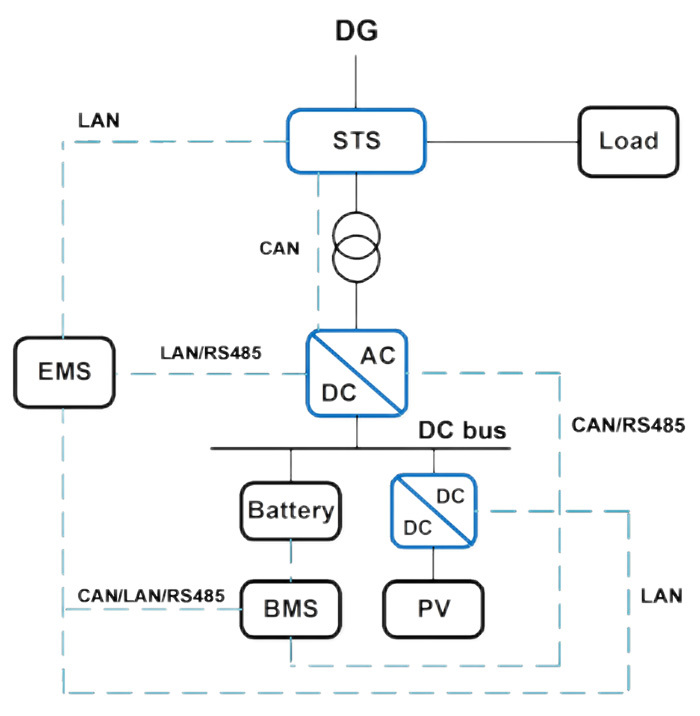

Photovoltaic + Energy Storage + DG
System Electrical Principle Diagram Introduction
This diagram depicts an enhanced energy management system that includes a DG (Diesel Generator) for additional power supply.
- AC Bus: Serves as the central hub for distributing AC power across the microgrid, connecting key components such as the grid, load, and static transfer switch (STS), ensuring smooth power flow.
- STS (Static Transfer Switch): A crucial component that manages the seamless transition between different power sources, including the diesel generator (DG) and the PV + battery storage system, guaranteeing reliable power supply to the load.
- PV Inverter: Converts the direct current (DC) generated by the photovoltaic (PV) panels into alternating current (AC), which can be used by the load or fed into the AC bus for distribution.
- Battery Energy Storage: Stores surplus energy produced by the PV system and provides stored energy during times of low solar generation or high demand, helping to balance energy supply and demand.
- Diesel Generator (DG): Acts as a backup power source when other sources (like the PV system or battery) are insufficient, ensuring continuous power supply to the grid or load.
- Grid Connection: Provides a connection to the utility grid, enabling the microgrid to import or export power as needed, ensuring stability and reliability of the power supply.
- EMS (Energy Management System): Oversees and optimizes the performance of the microgrid, controlling the flow of electricity between the PV system, storage, diesel generator, and the load based on energy availability and demand.
- Communication Interfaces (CAN/LAN/RS485): Facilitate data communication between the various components in the system, allowing for coordinated and efficient management of the microgrid operations by the EMS.
This description captures the key elements of the system, outlining their roles and how they work together to ensure reliable, efficient power distribution in the microgrid.
Expanded Application Directions
This diagram illustrates the integration of photovoltaic (PV) energy storage, diesel generators (DG), and the grid to form a reliable microgrid system. Its application scenarios include:
Remote Area Microgrid Formation:
By coupling PV energy storage and diesel generators, this system creates a stable microgrid capable of providing electricity in regions with limited or no grid access.
Backup Power Supply:
Diesel generators act as a secondary backup when PV energy and battery reserves are insufficient, ensuring continuous power supply during extended periods of low solar generation.
Diesel Generator Replacement:
Over time, PV energy storage reduces the dependency on diesel generators, lowering operational costs and environmental impact.
Improved Load Supply:
The system ensures efficient power distribution to connected loads by balancing PV energy, stored energy, and diesel power.
Flexible Energy Management:
Real-time energy management systems (EMS) optimize the use of renewable and stored energy while reducing the operating time of diesel generators.
For more information,don't hesitate to leave your email and tel and ask for a quotation. We have a professional technical team to provide you with a one-stop energy storage solution!Get a free quotation now!
Enclosure:
Next
Contact Us
Building 7, Cross Border E-Commerce Supervision Zone, Hefei, China







